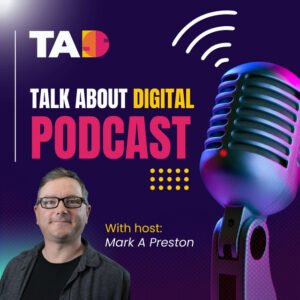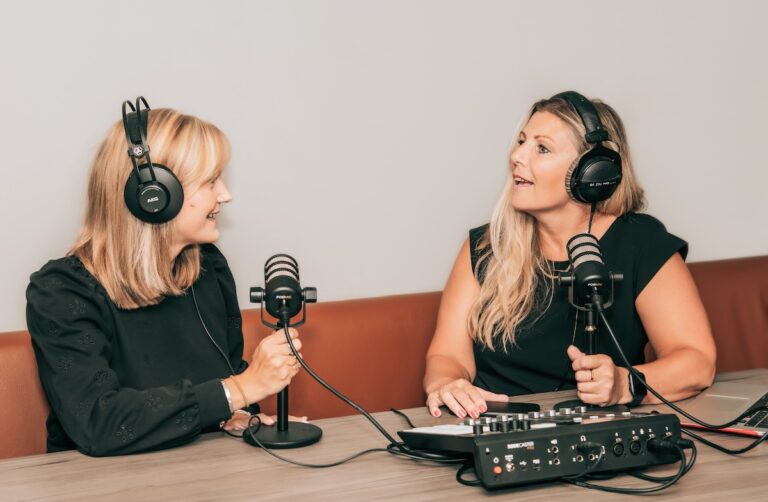In this step-by-step guide, Kath Lord-Green, aka Your Fairy Podmother® takes you from Planning to Launch.
Podcasting is a powerful tool for small and medium-sized enterprises (SMEs) in the UK. It offers a unique way to  engage with audiences, build brand loyalty, and establish authority in your industry. This guide will take you through the essential steps from planning to launching a successful podcast, ensuring you can tap into this growing trend effectively.
engage with audiences, build brand loyalty, and establish authority in your industry. This guide will take you through the essential steps from planning to launching a successful podcast, ensuring you can tap into this growing trend effectively.
Step 1
- Define Your Goals and Audience
Before diving into podcasting, it’s crucial to understand why you want to start a podcast and who you’re targeting. - Set Clear Goals
Are you looking to educate your audience, promote your products or services, or build a community around your brand? Defining your goals will shape your content and strategy. - Identify Your Audience
Determine who your target listeners are. Understand their interests, challenges, and what kind of content will provide value to them. This will help you create relevant and engaging episodes.
Step 2
Plan Your Content – A well-planned podcast keeps listeners coming back for more. Planning is key to maintaining consistency and quality.
- Choose a Format
Decide on the format that best suits your goals and audience. Common formats include interviews, solo shows, panel discussions, and storytelling. Choose one that you are comfortable with and that will engage your audience. - Create a Content Calendar
Plan your episodes in advance. Outline topics for each episode and schedule release dates. Consistency is important, so decide whether you’ll publish weekly, bi-weekly, or monthly. - Develop Episode Structure
Outline the structure of each episode. Include an introduction, main content, and a conclusion. Having a consistent structure helps listeners know what to expect.
Step 3
Gather Your Equipment – You don’t need to spend a fortune on equipment to produce a quality podcast. Practice with the equipment you already have, like a laptop, phone, or computer, before purchasing anything. Once you are sure it’s for you, here’s what you’ll need.
- Microphone
A good-quality microphone is essential for clear audio. The Audio-Technica ATR2100x-USB or the Samson Q2U are excellent budget-friendly options or Google for others. - Headphones
Invest in a pair of comfortable, closed-back headphones. The Audio-Technica ATH-M20x or the Sony MDR-7506 are reliable and affordable choices. However, using any headphones you already have (except wireless ones) should suffice for starters. - Pop Filter
A pop filter reduces unwanted popping sounds from plosive consonants (like “S” and “P” sounds). Inexpensive options can be found online. - Boom Arm or Microphone Stand
A boom arm or stand keeps your microphone steady and at the right height. Many budget-friendly options are available.
Step 4
Choose Recording and Editing Software – Free or low-cost software can help you record and edit your podcast professionally.
- Recording Software
- Audacity: A free, open-source audio recording and editing software that is user-friendly and widely
 used by podcasters.
used by podcasters. - GarageBand: Free for Mac users, GarageBand is versatile and great for recording and editing podcasts.
- Audacity: A free, open-source audio recording and editing software that is user-friendly and widely
- Editing Software
Both Audacity and GarageBand offer features to help you clean up your audio and add effects. Platforms like Descript allow you to record, edit, and transcribe all in one place, giving you more options for ease of use and low cost.
Step 5
Record and Edit Your Episodes – With your equipment and software ready, it’s time to record your episodes.
- Find a Quiet Space
Choose a quiet location to record your episodes to minimise background noise. Consider using blankets. foam panels, beanbags anything, to improve sound quality. - Record in Batches
Recording multiple episodes in one session can save time and help you stay consistent with your release schedule. - Edit Carefully
Spend time editing your episodes to remove mistakes, pauses, and background noise. BUT keep it authentic! Add intros, outros, and music to give your podcast a professional touch.
Step 6
Distribute Your Podcast– Once your episodes are ready, you need to get them to your audience.
- Choose a Hosting Platform
Use a podcast hosting platform like Buzzsprout, Podbean or Anchor (I use Buzzsprout) to upload your episodes. These platforms and more,will distribute your podcast to major directories like Apple Podcasts, Spotify, and other Indie Platforms. - Write Compelling Descriptions
Create engaging episode titles and descriptions to attract listeners. Include keywords to help your podcast appear in search results.
Step 7
Promote Your Podcast – Promotion is key to growing your listener base.
- Leverage Social Media
Use your existing social media channels to promote new episodes. Share clips, quotes, and behind-the-scenes content to engage your audience. - Collaborate with Others
Partner with other podcasters or influencers in your industry to expand your reach. Guest appearances can introduce your podcast to new audiences. - Engage Your Audience
Encourage listeners to leave reviews, subscribe, and share your podcast. Respond to feedback and incorporate listener suggestions into future episodes. - Use Your Website
Embed your podcast episodes on your website and create blog posts around each episode. This helps with SEO and provides additional content for your audience.
Step 8

Repurpose Your Content – Maximise the value of your podcast by repurposing content across different platforms.
- Transcriptions:
Convert podcast episodes into written transcripts and post them on your website as blog articles. This caters to those who prefer reading and improves SEO. - Social Media Clips
Extract short, engaging clips from your podcast episodes and share them on social media platforms like Instagram, X, LinkedIn, and Facebook. - Email Newsletters
Include highlights and key takeaways from your podcast episodes in your email newsletters to keep subscribers informed and encourage them to listen to the full episodes.
Conclusion
Podcasting is an effective and budget-friendly way for UK SMEs to engage with their audience, build brand loyalty, and establish authority in their industry. By following these steps, you can successfully plan, launch, and promote a podcast that resonates with your listeners and supports your business goals. With the right approach and commitment, podcasting can become a valuable addition to your marketing strategy, helping you connect with your audience in a meaningful and impactful way.
Go back on previous articles to read more on Podcasting for SMEs.
Dip Your Toe into Podcasting by Adding Audio to Your Existing Communications

